After the rapid development in recent years, LCD monitors still can't talk about popularizing two words, but more and more people are buying LCDs. However, the purchase of liquid crystal displays has a lot of knowledge, because there are traps everywhere, and if you are not careful, the interests of consumers will be infringed.
You may already know the essentials of purchasing and selling these products. However, when we visit the store and evaluate the products, we find that some “traps†that are hard to detect, but actually exist, are constantly being made for consumers. Trouble, these traps can also be avoided before buying the product. To this end, we specifically use this article to expose four little-known shopping traps for you, hoping to clear some obstacles for your purchase.
â— Guarantee no highlights, just a profit-seeking word gameWith the passage of time, LCDs are becoming more and more familiar to people. Therefore, the inevitable dead pixels of LCDs are being paid more and more attention by consumers. It can be said that many consumers will have a kind of bad points. The feeling of "smelling the wind", and even some consumers resolutely resist the LCD with bad points. After all, no one wants to spend money to be "stained" by the bad points.
With the continuous maturity and improvement of the technology of LCD panel manufacturers, the probability of occurrence of dead pixels in LCD panels has been well controlled, or it can be said that it is no longer difficult to buy an LCD without dead pixels. In order to increase the market competitiveness of the products, many brands have launched the "protection without highlights" sign, which attracted the attention of countless consumers. But you may not know, the "no highlights" here are somewhat of the taste of word games. Because "bright spot" is only one kind of bad point, the bad point should include "bright spot" and "dark spot". Therefore, an LCD that claims to "protect no highlight" does not mean "no bad point". And some profiteers just drilled this loophole.
When we visit the market, we often encounter it. Some consumers feel that they have a solid foundation in the "protection without highlights". Plus the brand is good and the price is suitable, so they will pay for it, but sometimes there will always be some accidents. Consumers who want to buy LCD will first consult the merchant. Generally speaking, the merchant will clearly express "protection point" (Note: the merchant does not say "protect no highlights", directly said "protection point"), and said that you must first pay the money to open the box. The reason is that things are not easy to sell after opening the box (I think this is reasonable, after all, no one is willing to buy a passive product). In this case, if the consumer pays the money, there will be three different results: the LCD does not have any bad points, so congratulations to you; the LCD has a bright spot, and the two do not say to you; The LCD of the box has dark spots, and the merchants can say that they can't be changed. The reason is very simple - the manufacturer only says "no highlights", except for the highlights, the rest of the bad points don't matter. Presumably, the result is not what everyone wants to see. It is also the most unacceptable to everyone.
â— The size is more than 20 inches, no pointIn addition, it must be noted that LCDs above 20 inches do not enjoy the "no bright spots" treatment. In other words, only LCDs with a size less than 19 inches have the "no highlights" treatment. Therefore, if the consumer buys a large-size LCD of 20 inches or more and wants to maintain the point, then it needs to be said in advance with the merchant, and the business should not be blindly believed. Because of the problem, the merchant first thinks of his own interests.
We believe that the best way is to consult the merchant in advance, the merchant clearly stated that there is no bad point, then there is room for negotiation even if there is a problem. If you don't say it well beforehand, if there is a bad point, no matter what you say, the merchant will not compromise, because the large LCD of 20 inches or more is not guaranteed. Maybe when the business will say "checkpoint can also add 200 yuan", then it is more reasonable, and if the merchant is not willing to replace the money in order to sell the goods, then the consequences are only borne by the consumers themselves.
In summary, the problem of the bad point on the surface is understood by everyone, but the consumer who suffers from the problem of the bad point is definitely not a minority. After all, the one that is bought is not sold. As consumers, we must legally protect our rights and interests. Consumers who want to buy LCDs in the near future must bear in mind and keep in mind. Next, the problem we are going to say is “dark spotsâ€, which is also a problem that cannot be ignored...
â— Dark spots, hidden deeperWhat is dark spot? This concept may not be well understood by many consumers. In fact, dark spots are more subtle than bright and bad points, but they have a much greater impact on use than bad points. Sometimes on some monitors, there will be some plaques that are not very large. The dark shifts are as big as the yellow beans. The big ones may have a big thumb. Unlike the bright spots and dark spots, the dark shifts only change the local color slightly. Deep, it is not easy to be seen when viewed from the front, and can only be found when viewed from the side.

The main reason for the formation of dark spots is caused by the long-term extrusion of external forces, and we think that it is very likely that it is in the transportation process, because the improper treatment leads to the appearance of dark spots. An LCD with a dark spot is usually more difficult to find on the front side, and the side view is relatively more obvious (as a test view angle). We recommend that you do not simply look at the display to find a bad point when purchasing LCD. You should view the screen surface from multiple angles and set the screen to white. If there is a dark spot problem at this time, then this LCD can't be purchased.
â— Remember to check your own before you buy.I remember when I collected the market in the market, we found that a consumer with LCD to find a merchant to replace, the reason is that there are dark spots, the merchant opened the package to check the screen does appear to have dark spots, but they also confidently said: "At the time, you didn't have these problems when you checked, and you have already taken it, we can't change it for you." After buying the LCD for two days, there was a problem. The consumer was certainly not willing. The result was a dispute with the merchant for a long time. Finally, Can only return without success.
In other words, the LCD has been taken away. It is difficult to make clear whether the dark spot is the problem of the machine itself or the cause of the consumer. The merchant will naturally not be willing to bear the trouble. The consumer can only accept the dumb. The consequences of eating Huanglian, who can’t say anything. Therefore, even if the chance of dark spots is very low, it is definitely not negligible.
â— LCD screen flashing must be carefulIf the CRT screen will flash, then the LCD screen will flash, which is somewhat difficult to understand (except for the black insertion technology), because compared to the CRT, the LCD basically has no concept of refresh rate, and basically there is no screen. The problem of flickering, these are basic common sense, but the flicker we are going to say here is not for the refresh rate...
I often try different LCDs. In the process of trial, I found that some LCDs have flickering problems, and this is difficult to find in the normal state. To verify whether there is flicker in the LCD screen, the easiest way is to open one. On the page of the picture page, use the mouse to select a "area". This area must contain a picture. At this time, carefully observe the picture. If the picture will flash, then this display cannot be used.
â— The reason why the screen flickersThere are many reasons why the LCD screen flickers. In foreign media articles, we learned that the "jitter" technology that almost all monitors use today is the culprit of the flickering of the screen. Display manufacturers will use the "jitter" technology to make the LCD panel that can only display 262K color, and obtain 16.2M color display capability. In this process, because the jitter algorithm is not sufficiently dense or the internal circuit design is not closed, it may bring the problem of flickering.
In addition, some LCDs do not have the problem of flickering in DVI mode, but the problem of switching to D-Sub mode will come to the forefront; of course, some DVI mode and D-Sub mode will have flickering problems. If you don't want to be troubled by the LCD screen flickering problem, then the easiest way is to do a test in the field, use the method we introduced earlier, flashing or not at a glance.
◠Don't pay for the “DVI signal line†twiceAs LCDs become more popular, consumers are increasingly inclined to purchase LCDs with DVI interfaces. Today, only a few LCDs for low-end users use a single D-Sub analog interface, and most products use DVI+D- Sub dual interface design. To be sure, all LCDs will be equipped with D-Sub signal lines. As for the DVI signal lines, it is hard to say.
From now on, ViewSonic, AOC, Samsung, and GreatWall all have DVI signal lines for all models with DVI interface. Philips originally did not send DVI signal lines, but it seems to have been given away recently, and LG and BenQ are somewhat confused. Therefore, everyone should consult clearly before buying.
Friends who often pay attention to LCDs may notice that most Samsung LCDs will post on the box "Where you buy any Samsung digital LCD monitor, which comes with an original digital signal cable worth 120 yuan." In some Samsung stores, the DVI signal line will be hidden privately. When consumers purchase the product and find that there is no DVI signal cable, and when they want the DVI cable, the merchant will say: "We have Samsung original factory here. DVI signal line, and the price of a machine to buy is 100 yuan, is the original Samsung, the quality is absolutely nothing to say, so many consumers are fooled, in order to prevent this unethical practice of individual businesses, Samsung LCD packaging There are related logos on it, which is a relatively good method.
In order to protect consumers' own rights and interests, we believe that the easiest way is to shop around, and before buying and paying, first ask the merchant whether the DVI signal line is standard. Of course, if you already know that this product comes standard or does not have a DVI signal cable as standard, you can skip this step.
â— Write to the endFor experienced players, this article may not be worthwhile, but we believe and personally experienced the situation of consumer losses. On the occasion of "3.15", we offer this article to readers, hoping to help you to a certain extent. As the saying goes, the ones that are bought are not sold. As a smart consumer, we have the right to protect our own interests and interests!
What is the LCD color coverage, LCD phosphor selection instructions:Briefly introduce LCD TV and color filter (CF) and white LED that affect color gamut coverage, and explain the conversion relationship between CF and white LED in LCD, and the calculation method of color gamut coverage. A phosphor scheme for backlighting white LEDs with different color gamut coverage is briefly described with examples.
1 IntroductionDue to its high color performance, high light efficiency, low carbon environmental protection and energy saving, a large number of LCD TVs on the market are beginning to use LEDs as backlights. However, due to the variability of LED white light synthesis, many packagers' technicians are not well aware of how to choose a phosphor solution that matches the LCD under the known color gamut coverage requirements. At the same time, due to the different LCDs of various TV manufacturers, the technicians of the package manufacturers need to perform multiple and long-term package verification on the phosphor solution that meets the requirements of color gamut coverage and matches the LCD. This paper mainly explains and analyzes the conversion relationship between CF and white LED in LCD, the calculation method of color gamut coverage and how to choose the phosphor matching with CF in LCD under the requirement of known color gamut coverage. For reference by the packaging technician.
2 LCD TV and color gamut coverage2.1 LCD TV Introduction
LCD: Abbreviation for Liquid Crystal Display, the full name of liquid crystal display, which includes TFT, UFB, TFD, STN and other types of liquid crystal display.
Liquid crystal: a substance between a solid and a liquid. It is an organic compound with a regular molecular arrangement. If it is heated, it will be in a transparent liquid state. If it is cooled, crystal particles will appear. Turbid solid state. Because of its characteristics, it is called liquid crystal. The liquid crystal molecular structure used for the liquid crystal display is similar to that of a fine match stick, and is called a NemaTIc liquid crystal. A liquid crystal display made of such a liquid crystal is also called an LCD.
LCD TV: A TV set that uses a liquid crystal display to make a display.
2.2 LCD construction and imaging principles2.2.1 LCD construction
Taking a TFT type liquid crystal display as an example, the structure mainly includes a backlight, a light guide plate, an upper and lower polarizing plate, a liquid crystal, a color filter, a thin film transistor, etc. (the structure is shown in FIG. 1), and the main structural functions are as follows:
1. Back Light: The principle of LCD display is to block the light and light by the liquid crystal to control the light and dark. It is necessary to have a light source to see the image on the screen, so the backlight is responsible for providing the most basic for LCD display. Light source.
2. Light Guide Plate: distributes the light evenly across the entire screen;
3. Up/Down Polarizer: The direction of the light sent by the backlight is inconsistent and radial. If such light passes through the twist of the liquid crystal molecules, we still can't see the image we want to see on the screen. At this time, the polarizing plate below assumes the work of normalizing the direction of the light to the liquid crystal layer.
4. Thin Film Transistor (TFT): Controls the twist angle of liquid crystal molecules
5. Liquid crystal: This layer of liquid crystal molecules is twisted under the control of the TFT, and the light with the same direction is controlled to be bright, so that the brightness of the light to the rear pixel unit changes.
6. Color Filter: After the white filter is filtered, we can see that the light corresponding to the color of the filter is transmitted, so in the LCD screen, the function of the color filter is to color. .
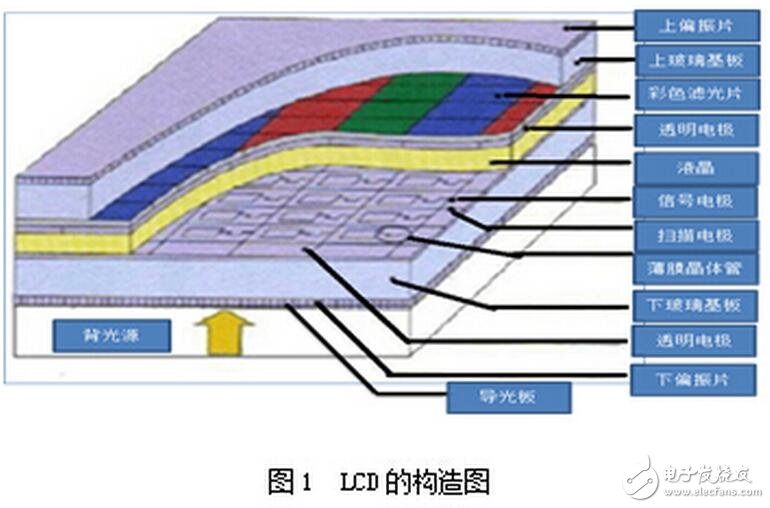
The principle of LCD imaging is to place the liquid crystal between two sheets of conductive glass. By controlling the driving of the electric field between the upper and lower polarizing plates and the upper and lower electrodes, the electric field effect of the liquid crystal molecules is twisted and nematic to control the transmission of the backlight or Masking, combined with other control and auxiliary function layers to achieve the function of restoring the picture.
2.2.3 LCD TV backlight introduction
Since the liquid crystal must be illuminated by an additional light source, the backlights commonly used in LCD TVs include CCFL (Cold Cathode Fluorescent Lamp, which is our common fluorescent lamp), LED (Light Emitting Diode), and HCFL (Hot Cathode Fluorescent Lamp). Among them, CCFL is currently the most commonly used LCD backlight, usually called traditional backlight;
CCFL vs. LED:
CCFL - made of hard glass and trichromatic phosphors, the tube has a proper amount of mercury and inert gas, the inner wall of the tube is coated with phosphor, and there is one electrode at each end. The disadvantage is that the color displayed is limited. .
LED - is a semiconductor solid-state light-emitting device that uses a solid semiconductor chip as a light-emitting material to recombine excess energy in a semiconductor by carrier to cause photon emission, directly emitting red, yellow, blue, green, cyan, and orange. , purple, white light. Because LED LEDs have good color performance, they have completely replaced the light source of traditional cold cathode fluorescent tubes.
2.3 gamut coverage2.3.1 Meaning of gamut coverage
Color Gamut: refers to the range of the number of colors that a display system can express.
In order to be able to visually represent the concept of color gamut, the CIE International Lighting Association has developed a method for describing the color gamut: the CIE-xy chromaticity diagram. In this coordinate system, the gamut range that each display system can represent is represented by a triangular area composed of RGB three-point lines. The larger the area of ​​the triangle, the larger the gamut range of such a display device.
Color gamut coverage: The horseshoe-shaped chromaticity triangle marked with color on the CIE-xy chromaticity diagram is the color area that the human eye can see. If a system can fully reproduce the color in this horseshoe-shaped area, it can be said to be color. The domain coverage is 100%. The triangular regions composed of the three primary color coordinates of R, G, and B when the colors are reproduced by R, G, and B are the color reproduction regions determined by the three primary colors, and the ratio of this region to the horseshoe region is the color gamut coverage. Therefore, the gamut coverage ratio is the ratio of the area of ​​the triangular area composed of three basic color coordinates of R, G, and B to the area of ​​the triangular area composed of the three primary color coordinates of the standard R, G, and B.
2.3.2 Standards for gamut coverage
Traditionally, we refer to gamut coverage as the color gamut. In different fields, the requirements for the three primary color coordinates of the standard R, G, and B are different, which involves different color gamut evaluation criteria. The gamut standards generally have the following:
1) NTSC standard: In 1953, the National Television Standards Committee (NTSC) based on the CIE1931 chromaticity diagram developed the NTSC standard, which is also a commonly used standard in China.
2) ITU-R BT.709 standard: A standard established by the International Radio Consultative Committee (CCIR) in 1988 for television production in high definition television (HDTV) studios.
3) sRGB standard: In 1996, the gamut standard for digital image developed by the International Electrotechnical Commission (IEC), which is mainly applied to digital image acquisition equipment, is not widely available on the display.
4) Adobe RGB standard: In 1998, Adobe proposed a color space wider than sRGB, which is generally used in printing and publishing, image processing and other fields.
5) ITU-R BT.1361 standard: Wide color gamut standard based on Pointer color gamut established by the International Telecommunication Union Radiocommunication Group (ITU-R) in 1988.
6) xvYCC standard: The latest generation of optical gamut standard approved by the International Electrotechnical Commission (IEC) and published as an international standard in January 2006. Its color range not only greatly exceeds the NTSC gamut range, but also reaches the sRGB color gamut. Times, this specification can define all colors visible to the naked eye.
The common standards in the above gamut standards are: sRGB, NTSC and Adobe RGB. The coordinates of the white light position, color temperature and RGB primary color are shown in Table 1:
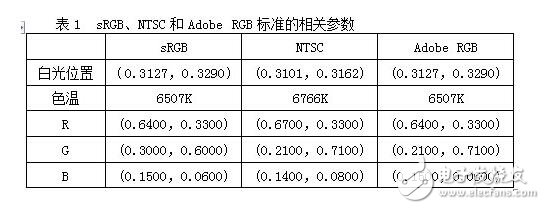
In this paper, the color gamut we are talking about is the color gamut under the NTSC standard, referred to as the NTSC color gamut.
Combined with the concept of color gamut coverage, it can be deduced that the NTSC color gamut is the ratio of the triangle region composed of a certain RGB three primary color coordinates to the triangular region composed of three color coordinates of NTSC standard RGB (schematic diagram is shown in Figure 2). The higher the ratio, the color The better the performance.
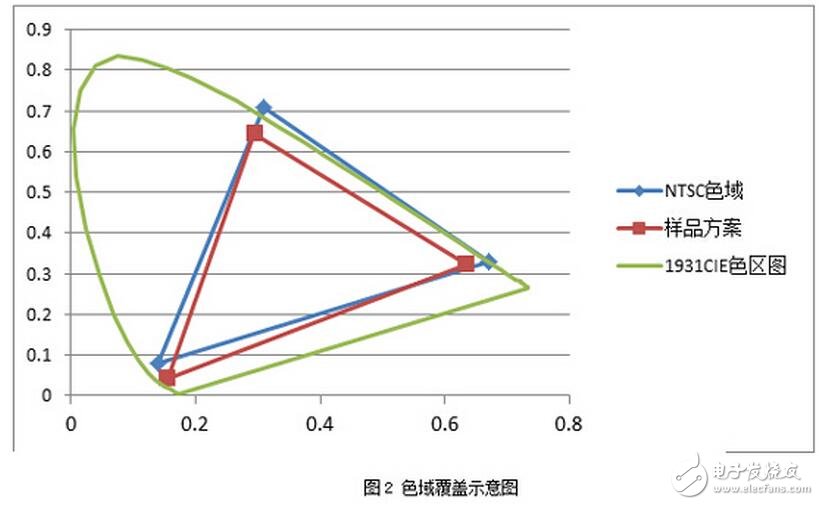
The development of backlights from CCFL to LEDs indicates that people are increasingly demanding the range of colors that can be expressed by the system, so the future high color gamut will become the trend of LCD TV development.
2.4 Factors affecting gamut coverageCombined with the structure and imaging principle of the LCD in 2.2, it can be known that in the LCD TV, the light of the backlight passes through the CF to obtain the light of the three primary colors of RGB. At the same time, the content of 2.3 is known that the NTSC color gamut is the ratio of the triangle region composed of a certain RGB three primary color coordinates to the triangular region composed of three color coordinates of NTSC standard RGB. Therefore, the key factors affecting the gamut coverage are the three color coordinates of the backlight (mainly white LED), CF, and standard RGB. Under the NTSC standard, the standard RGB three color coordinates are known.
2.4. Introduction of 1 white LED
The white LED is a device packaged by chips, brackets, phosphors, glues, etc., and its luminescence spectrum can be visually described by a continuous RGB curve. In practical applications, white LEDs generally have the following two implementations:
1) Blu-ray chip (B) + yellow phosphor (Y);
2) blue chip (B) + green phosphor (G) + red phosphor (R);
2.4.2 Introduction to CF
Structure of CFIt is known in the article 2.2.1 that white light passes through the filter in the LCD (the position in the LCD is shown in Figure 1), and the light corresponding to the color of the filter will be transmitted, indicating that CF has the ability to separate a certain white light into R, G, B three-color light function.
CF is actually composed of three kinds of filters: R, G, and B (the plan is shown in Figure 3 and the cross-sectional view is shown in Figure 4). Only the light with the spectrum of the filter can penetrate the filter better. After the spectrum passes through the R, G, and B filters of CF, a new spectrum is obtained (this transformation is shown in Figure 5). The spectrum is decomposed by R, G, and B to obtain three independent R, G, and B. spectrum.


LED white light passes through CF to get another new white light spectrum. This new white light is actually composed of three independent R, G, and B spectra. The detailed process is as follows:

1. The characteristics of a CF model can be represented by a curve image (Fig. 7). The curve is actually composed of three single curves of R, G, and B (Fig. 8). The meaning of each curve can be simple. The understanding is as follows:
Curve - the peak is around 650nm, the band distribution is 570-780nm, which means that the light in the 570-780nm band can pass, and the other bands will be filtered out. At the same time, in the 570-780nm band that can pass, and because of the wavelength The difference in energy intensity that leads to the difference is also different.
Curve - the peak is around 530nm, the band distribution is 465-615nm, which means that the light in the 465-615nm band can pass, and the other bands will be filtered out;
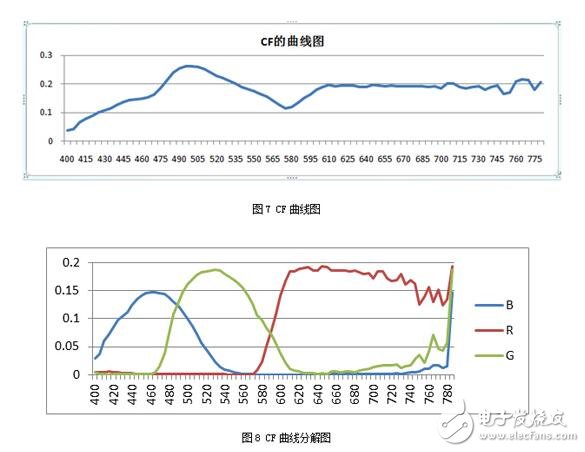
Curve - the peak is around 460nm, the band distribution is 400-520nm, which means that the light in the 400-520nm band can pass, and the other bands will be filtered out;
2. There are differences between different manufacturers and different types of CF. Now compare the curves of R, G and B with two common CFs in China.
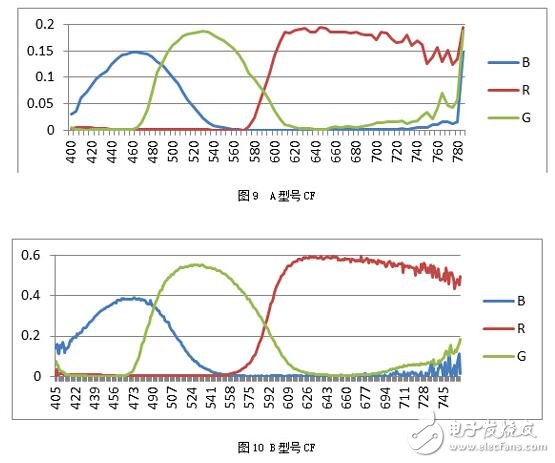
According to the analysis, the peak and half-wave widths of the R, G, and B curves in the two CFs of A and B are as follows:
Table 2: Peak and half-wave widths of the R, G, and B curves in the two CFs A and B

The above data shows that although the R, G, and B parameters of the two types of CF are roughly the same, the details still differ, so in the application, the specific CF model needs to be determined to determine the matching scheme.
2.5 Calculation of gamut coverageDescription: According to the introduction of 2.4.2 CF, LED white light will get 3 single R, G, B spectra after CF, and then the three single R, G, B spectra will be mixed into white light after CF. .
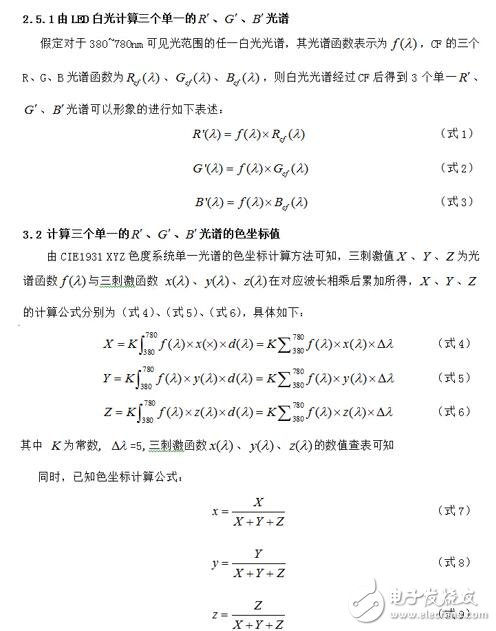 \
\ 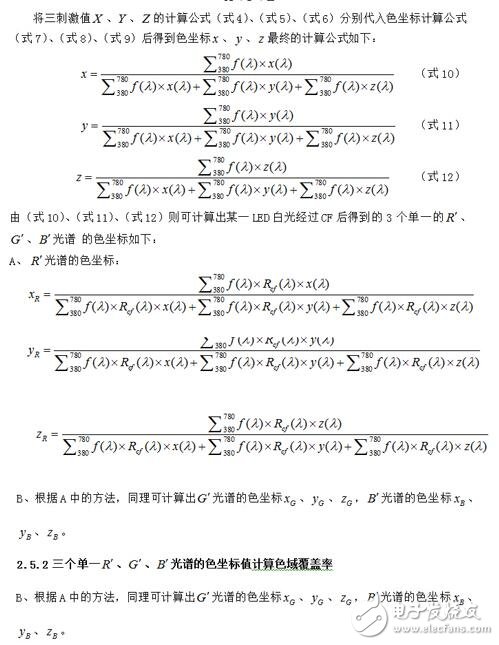
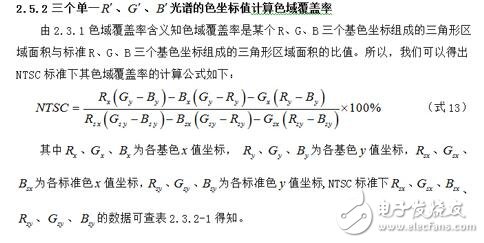
3 color gamut coverage and selection of phosphor scheme
3.1 Characteristics of different system phosphorsThe peak wavelength and half-wave width are distinguished. The characteristics of LED phosphors of different systems can be summarized as follows:
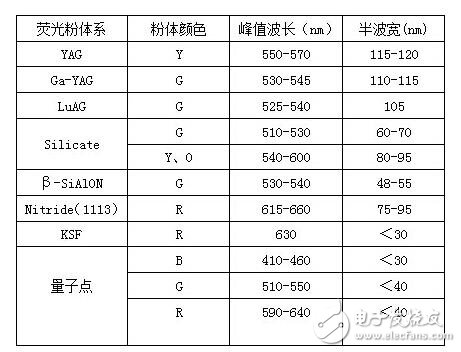
Table 3 Peak wavelength and half-wave width parameters of LED phosphors of each system
3.2 Color gamut coverage and selection of phosphor schemeAnalysis 1. From the theoretical analysis of 2.4.2 CF, it can be seen that the peaks of the R curves in the two commonly used CFs in China are around 650 nm and the half-wave width is 100 nm. The peak of the G curve is around 530 nm and the half-wave width is about 100 nm. The peak value of the curve is between 460-475 nm and the half-wave width is 90 nm. This indicates that in order to match the corresponding CF, the peak wavelength and half-wave width of the powder should be paid attention to when selecting the phosphor scheme.
Analysis 2, because the phosphor is encapsulated into LED white light, it is a continuous waveform composed of RGB (Fig. 11). In order to make white light better match CF, three narrower half-width R, G, B waveforms are needed. (Figure 12). When the half-width of the phosphor is narrower, the whole spectrum tends to the spectrum of monochromatic light. At this time, the color purity of the phosphor is higher, and the white light spectrum mixed by such phosphor is closer to the ideal. White light spectrum (Fig. 13), such white light passes through CF, and the color gamut coverage is high.
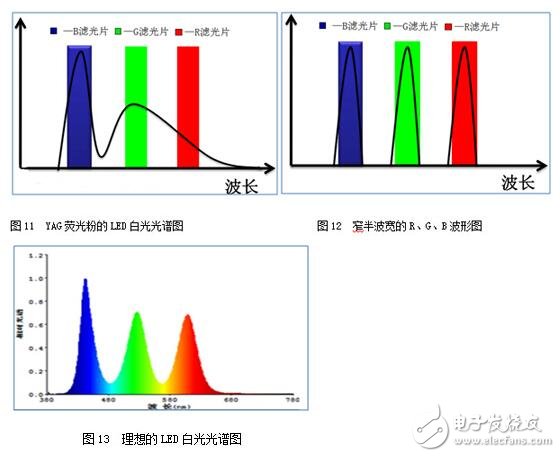
Analysis 3, from the meaning of color gamut coverage, the color gamut coverage is the area of ​​the triangle area composed of three basic color coordinates of R, G, B and the triangular area of ​​the standard R, G, B three primary color coordinates. The ratio, which indicates that the coordinates (x, y) of the phosphor should be also considered when selecting the phosphor scheme.
Based on the analysis of the above three points, the realization of white light, and Table 3.1-1, it can be seen that in the selection of the phosphor scheme, Ga powder can be selected from Ga-YAG, LuAG, Silicate, β-SiAlON, and quantum dots, and R powder can be selected from Nitride. KSF, quantum dots. At the same time, in order to achieve the best color gamut coverage, you can choose a narrower half-width phosphor to match.
For example: G powder of β-SiAlON + R powder of quantum dots, G powder of quantum dots + R powder.
3.3 Case description of different color gamut coverage requirements and phosphor schemesCombined with the existing materials and LED packaging experiments in the industry, the phosphors required for different color gamut coverage (70%, 75%, 80%, 85%, 90%, 95%) of the NTSC standard under the A model CF model are sequentially illustrated. The matching scheme, its parameters and the LED white light spectrum after encapsulation are as follows:
Table 4 Phosphor parameters of different color gamut coverage requirements of NTSC standard under A
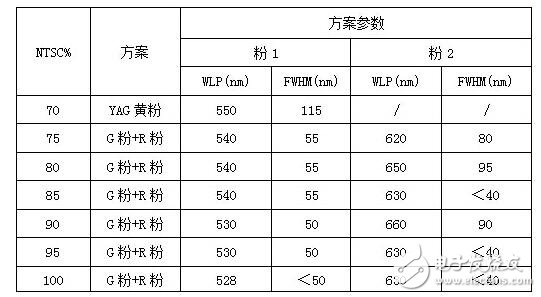
Note: The above simply enumerates some of the phosphor program parameters that meet the NTSC standard color gamut coverage requirements.
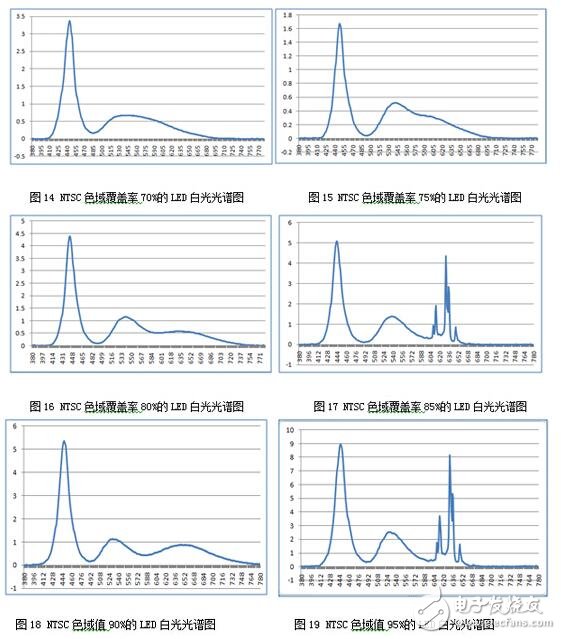
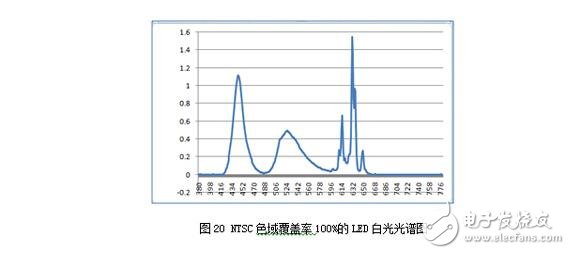
This paper briefly introduces LCD TV and CF and white LED which affect the gamut coverage. It also explains the conversion relationship between CF and white LED in LCD and the calculation method of color gamut coverage. At the same time, it covers different color gamut with examples.率下背光用白光LEDçš„è§å…‰ç²‰æ–¹æ¡ˆä½œäº†ç®€ç•¥ä»‹ç»ã€‚
Various products of Jewelry USB Flash Drive, including Jewelry USB Flash Drive Gift Box, Jewelry USB Logo, Jewelry USB Stick, Jewelry Usb Memory Stick, Jewelry Usb 2.0 Memory Flash Stick Pen Drive and so on. We also providing product images and basic parameters with each Jewelry USB Flash Drive and Jewelry USB Flash Drive OEM 3D inside engraved Logo;
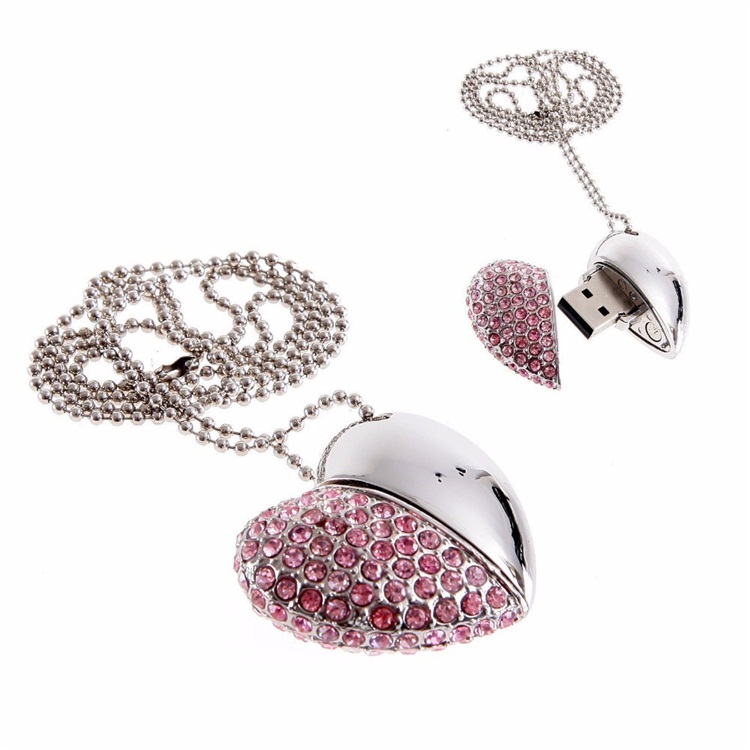
Jewelry USB Flash Drive is An ideal way to store all your pictures, documents, music and videos. Jewelry USB Flash Drive Can act as a wonderful gift for your friends and families and A great way to distinguish your masses of USB flash drives from each other as our cute USB come in a variety of variations for every day use.
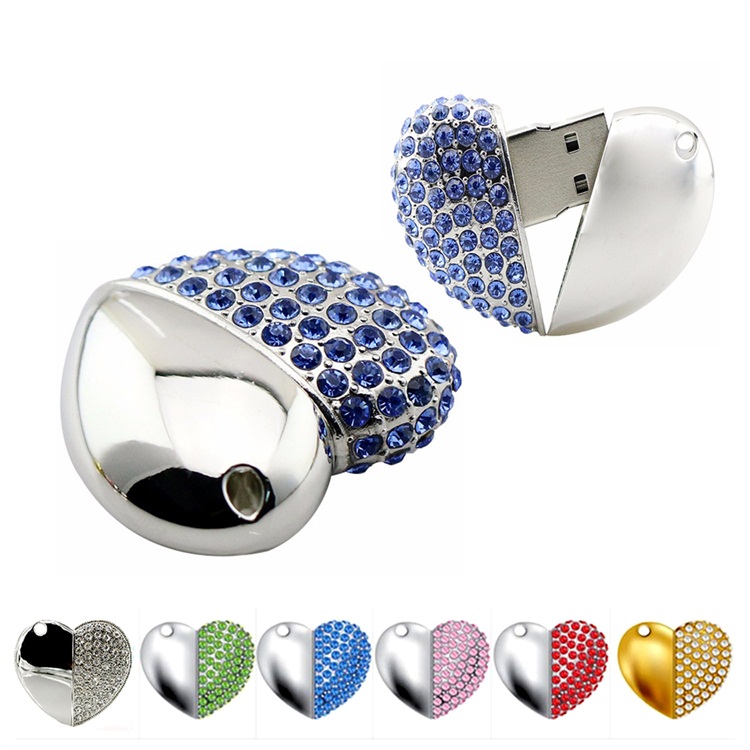
- Compatibility: Desktop, Laptop, Macintosh, Tablet, Speakers all with USB1.0 and 2.0.
- Operating System : Windows7/Vista/XP/2000/ME/NT/98,Linux (Sometimes incompatible with Mac OS 9.X/Linux2.4)
- Fine choice for advertisement allow to print LOGOs and advertisement.
- Very Low Power Consumption, durable solid-state storage.
- Small and exquisite design brings much convenience.
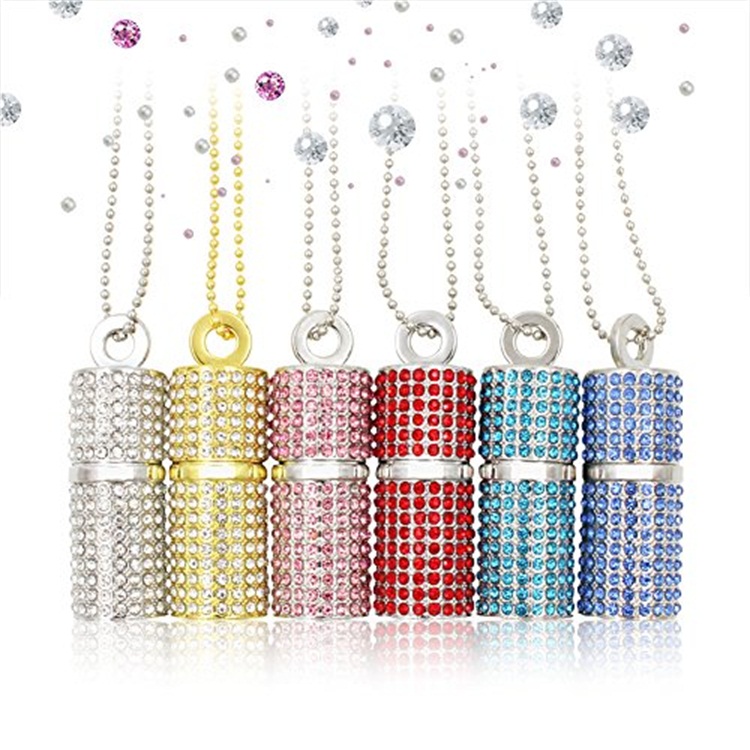
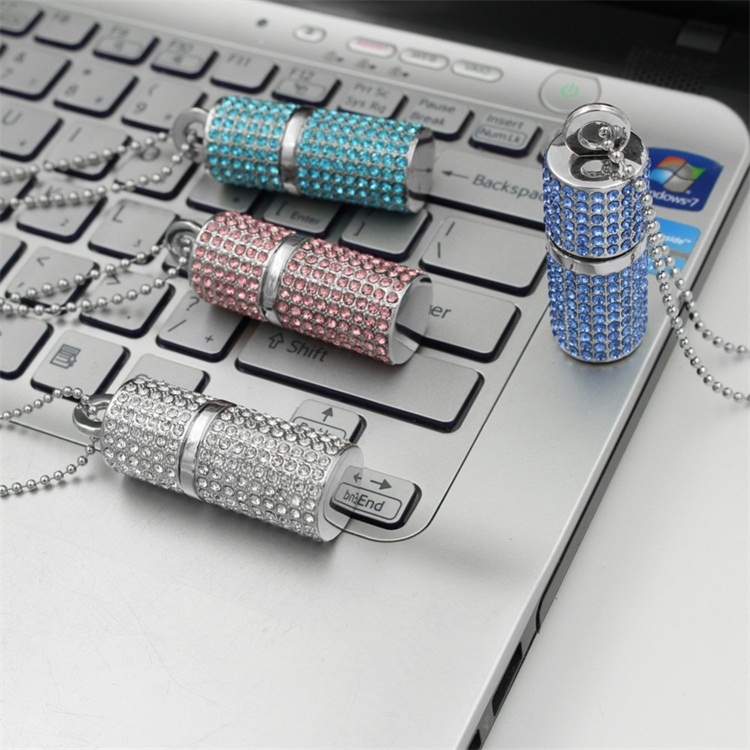
We are a professional Chinese manufacturer of Jewelry USB Flash Drive, and look forward to your cooperation!
Jewelry Usb Flash Drive,Heart Shape Jewelry Usb Flash Drive,Jewelry Diamond Usb Flash Drive,Usb Flash Drive
Reteck Electronic Co., Ltd. , https://www.reteck.com